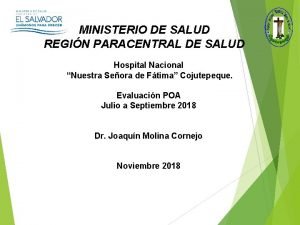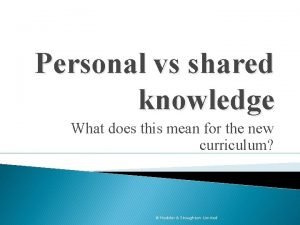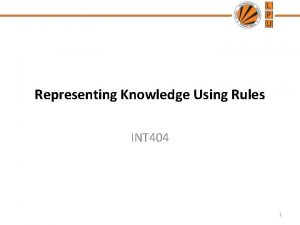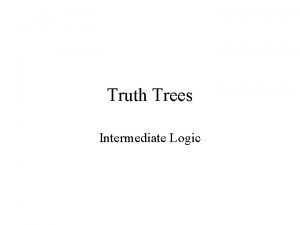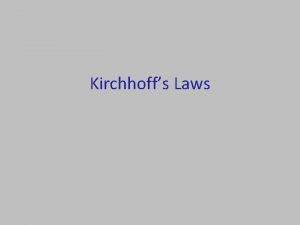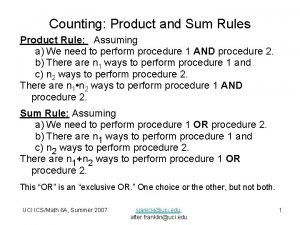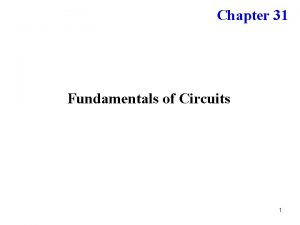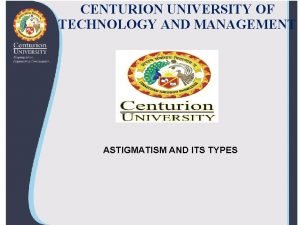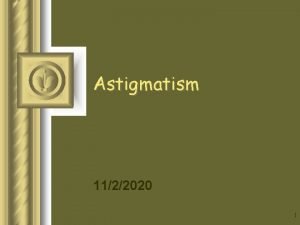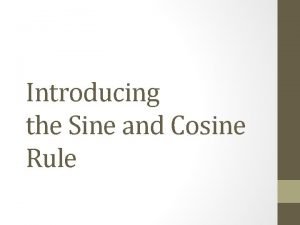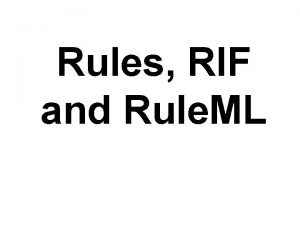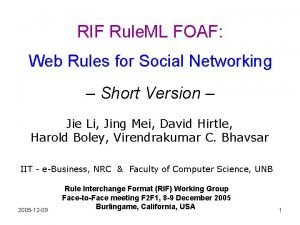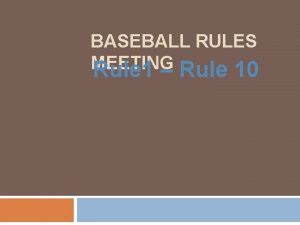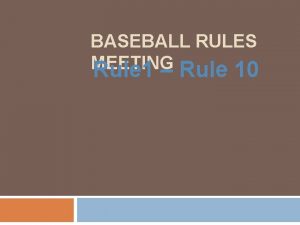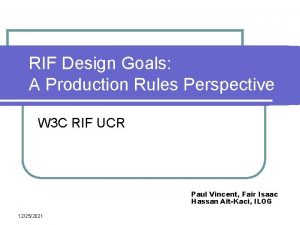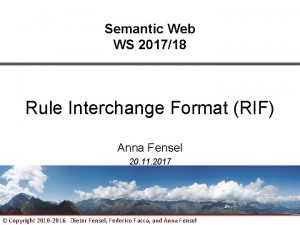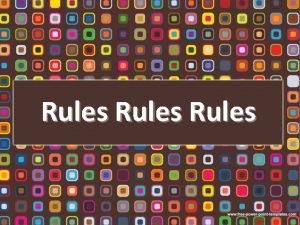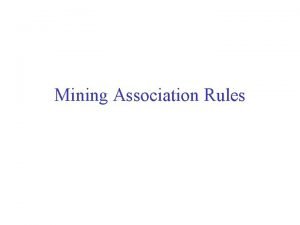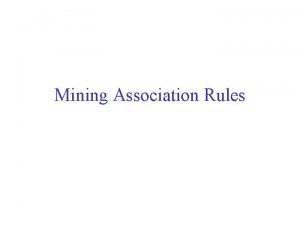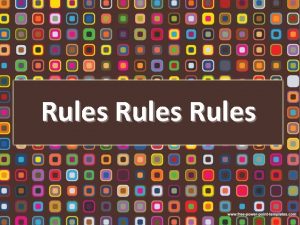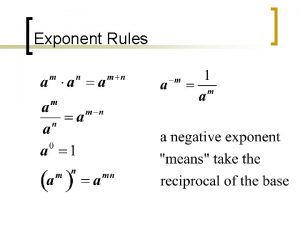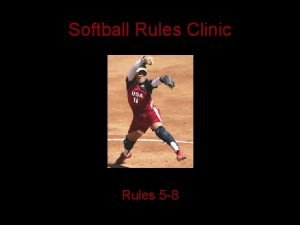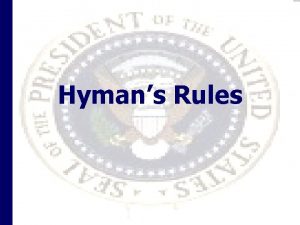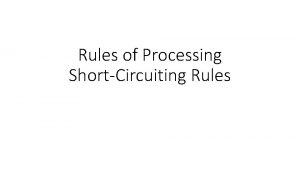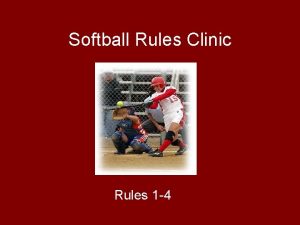Rules RIF and Rule ML Rule Knowledge l























- Slides: 23

Rules, RIF and Rule. ML

Rule Knowledge l l Rules generalize facts by making them conditional on other facts (often via chaining through further rules) Rules generalize taxonomies via multiple premises, n-ary predicates, structured arguments, etc. Two uses of rules top-down (backward-chaining) and bottom-up (forward-chaining) represented only once To avoid n 2–n pairwise translators: Int'l standards with 2 n– 2 in-and-out translators: – Rule. ML: Rule Markup Language (work with ISO, OMG, W 3 C, OASIS) l – ISO: Common Logic (incl. CGs & KIF: Knowledge Interchange Format) l – – 2 Collaboration on Relax NG schemas for XCL 2 / CL Rule. ML OMG: Production Rules Representation (PRR), SBVR, and API 4 KB W 3 C: Rule Interchange Format (RIF) l – Deliberation Rule. ML 1. 0 released as a de facto standard Gave rise to open-source and commercial RIF implementations OASIS: Legal. Rule. ML

The interchange approach l W 3 C’s RDF stack is an integrated solution for encoding & interchanging knowledge – – l There are other approaches to standardizing rule languages for knowledge exchange – – l Supporting OWL (DL) constrains it quite a bit E. g. , preventing adoption of an OWL rule standard Rule. ML: Rule Markup Language, an XML approach for representing rules RIF: Rule Interchange Format, a W 3 C standard for exchanging rules Neither tries to be compatible with OWL

Many different rule languages l There are rule languages families: logic, logic programming, production, procedural, etc. – Instances in a family may differ in their syntax, semantics or other aspects l Jess production rule language (defrule r 42 (parent ? a ? b) (male ? a) => (assert (father ? a ? b))) l Prolog logic programming language father(A, B) : - parent(A, B), Male (A). l Common Logic logic format (=> (and (paent ? a ? b) (male ? a)) (father ? a ? b))

X Interchange Format l Rather than have N 2 translators for N languages, we could – Develop a common rule interchange format – Let each language do import/export mappings for it l Two – – modern interchange formats for rules Rule. ML: Rule Markup Language, an XML approach for representing rules RIF: Rule Interchange Format, a W 3 C standard for exchanging rules

Rule. ML l Rule. ML's goal: express both forward (bottom-up) and backward (top-down) rules in XML l See http: //ruleml. org/ l Effort began in 2001 and has informed and been informed by W 3 C efforts l An “open network of individuals and groups from both industry and academia”

Taxonomy of Rule. ML rules from Boley et. al. , Rule. ML 1. 0: The Overarching Specification of Web Rules, 2010. http: //bit. ly/Rule. ML

RIF l W 3 C Rule Interchange Format l Three dialects: Core, BLD, and PRD – – – Core: common subset of most rule engines, a "safe" positive datalog with builtins BLD (Basic Logic Dialect): adds logic functions, equality and named arguments, ~positive horn logic PRD (Production Rules Dialect): adds action with side effects in rule conclusion l Has a mapping to RDF

An example of a RIF rule From http: //w 3. org/2005/rules/wiki/Primer Document( Prefix(rdfs <http: //www. w 3. org/2000/01/rdf-schema#>) Prefix(imdbrel <http: //example. com/imdbrelations#>) Prefix(dbpedia <http: //dbpedia. org/ontology/>) Group( Forall ? Actor ? Film ? Role ( If And(imdbrel: plays. Role(? Actor ? Role) imdbrel: role. In. Film(? Role ? Film)) Then dbpedia: starring(? Film ? Actor) )

Another RIF example, with guards From http: //w 3. org/2005/rules/wiki/Primer Document( Prefix(rdf <http: //www. w 3. org/1999/02/22 -rdf-syntax-ns#>) Prefix(rdfs <http: //www. w 3. org/2000/01/rdf-schema#>) Prefix(imdbrel <http: //example. com/imdbrelations#>) Prefix(dbpedia http: //dbpedia. org/ontology/) Group( Forall ? Actor ? Film ? Role ( If And(? Actor # imdbrel: Actor ? Film # imdbrel: Film ? Role # imdbrel: Character imdbrel: plays. Role(? Actor ? Role) imdbrel: role. In. Film(? Role ? Film)) Then dbpedia: starring(? Film ? Actor) )))

Rif document can contain facts The following will conclude bio: mortal(phil: Socrates) Document( Prefix(bio <http: //example. com/biology#>) Prefix(phil <http: //example. com/philosophers#>) Group( If bio: human(? x) Then bio: mortal(? x) ) Group( bio: human(phil: Socrates) ))

Another RIF example (PRD) From http: //w 3. org/2005/rules/wiki/Primer Document( Prefix(rdfs <http: //www. w 3. org/2000/01/rdf-schema#>) Prefix(imdbrelf <http: //example. com/fauximdbrelations#>) Prefix(dbpediaf <http: //example. com/fauxibdbrelations>) Prefix(ibdbrelf <http: //example. com/fauxibdbrelations#>) Group( Forall ? Actor ( If Or(Exists ? Film (imdbrelf: win. Award(? Actor ? Film)) Exists ? Play (ibdbrelf: win. Award(? Actor ? Play)) ) Then assert(dbpediaf: award. Winner(? Actor)) ) imdbrelf: win. Award(Roberto. Benigni Life. Is. Beautiful) ))

Why do we need YAKL l YAKL: Yet another knowledge language l Rules are good for representing knowledge l Rule idioms have powerful features that are not and can not be supported by OWL – – Non-monotonic rules Default reasoning Arbitrary functions, including some with side effects etc.

Non-monotonic rules l Non-monotonic rules use an “unprovable” operator l This can be used to implement default reasoning, e. g. , – assume P(X) is true for some X unless you can prove hat it is not – Assume that a bird can fly unless you know it can not

monotonic can. Fly(X) : - bird (X) bird(X) : - eagle(X) bird(X) : - penguin(X) eagle(sam) penguin(tux)

Non-monotonic can. Fly(X) : - bird (X), + not(can. Fly(X)) bird(X) : - eagle(X) bird(X) : - penguin(X) not(can. Fly(X)) : - dead(X) eagle(sam) penguin(tux)

Default rules in Prolog l In – l prolog it’s easy to have Default( ? head : - ? body ). Expand to – ? head : - ? body, + not(? head). l So – default(can. Fly(X) : - bird(X)) l Expands – to can. Fly(X) : - bird(X), +(not(can. Fly(X))).

Rule priorities l This approach can be extended to implement systems where rules have priorities l This seems to be intuitive to people – used in many human systems – E. g. , University policy overrules Department policy – The “Ten Commandments” can not be contravened

Two Semantic Webs?

Limitations l The rule inference support not integrated with OWL classifier – New assertions by rules may violate existing restrictions in ontology – New inferred knowledge from classification may produce knowledge Inferred useful for rules 1 Knowledge 2 Ontology Classification Rule Inference 4 Inferred Knowledge 3

Limitations l Existing solution: solve possible conflicts manually l Ideal solution: a single module for both ontology classification and rule inference l What if we want to combine nonmonotonic features with classical logic? l Partial Solutions: – – Answer set programming Externally via appropriate rule engines

Summary l Horn logic is a subset of predicate logic that allows efficient reasoning, orthogonal to description logics l Horn logic is the basis of monotonic rules l DLP and SWRL are two important ways of combining OWL with Horn rules. – DLP is essentially the intersection of OWL and Horn logic – SWRL is a much richer language

Summary (2) l Nonmonotonic rules are useful in situations where the available information is incomplete l They are rules that may be overridden by contrary evidence l Priorities are sometimes used to resolve some conflicts between rules l Representation straightforward XML-like languages is
 Xpert® mtb/rif
Xpert® mtb/rif Hospital nuestra señora de fatima cojutepeque
Hospital nuestra señora de fatima cojutepeque Knowledge creation and knowledge architecture
Knowledge creation and knowledge architecture What is shared knowledge
What is shared knowledge Knowledge shared is knowledge squared
Knowledge shared is knowledge squared Knowledge shared is knowledge multiplied interpretation
Knowledge shared is knowledge multiplied interpretation Contoh shallow knowledge dan deep knowledge
Contoh shallow knowledge dan deep knowledge A posteriori knowledge is
A posteriori knowledge is Book smart vs street smart
Book smart vs street smart Knowledge and knower
Knowledge and knower Gertler econ
Gertler econ Representing knowledge using rules
Representing knowledge using rules Which of the truth-tree rules are branching rules
Which of the truth-tree rules are branching rules Unlike traditional production rules, association rules
Unlike traditional production rules, association rules Obtuse angle rules
Obtuse angle rules Soh cah toa rule
Soh cah toa rule Loop rule and junction rule
Loop rule and junction rule Rule of sum and product
Rule of sum and product Kirchhoff loop rule
Kirchhoff loop rule What is with the rule and against the rule astigmatism
What is with the rule and against the rule astigmatism With the-rule astigmatism examples
With the-rule astigmatism examples With the rule astigmatism
With the rule astigmatism When to use sine and cosine rule
When to use sine and cosine rule Atomic orbital
Atomic orbital

